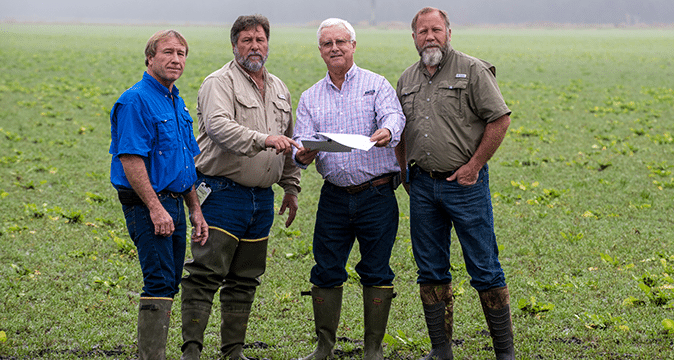Staples of Louisiana cuisine, rice and crawfish pair well when farmed together. Add in the 4R Nutrient Stewardship practices and you’ll cook up a winning farm operated by 4R advocates. Brothers C.J., Greg, and Jeff Durand began raising crawfish with their father in the 1970s. No-till rice was added in 1980, and the operation has since grown to 1,250 acres.
Land leveling and water management are key considerations for growing rice, but it takes the 4R Nutrient Stewardship protocols to continuously improve the soil health year after year. Three primary sustainability goals complement the 4R practices. They are:
Economic: maximize ROI and profitability
Social: provide nutritious rice and crawfish, reduce labor in the field by letting crawfish feed on rice stubble, which supports no-till and minimum-till and use resources efficiently
Environmental: improve soil health by increasing organic matter and minimizing nutrient losses to the surrounding environment.
The Durands began working with G&H Seed Company, now Sanders, a Pinnacle Agriculture brand, in the 1980s. Earl Garber, a producer support specialist, has worked with the team for six years. The Durands now collect soil samples in 2.5-acre grids every three to four years and that data is turned into soil maps with CEC zones. Combined with yield monitoring data, tissue sampling, satellite imagery, and crop removal rates, the result is better fertilizer prescriptions for each field, improved soil health, and healthy yields.
Best Practice Management
- Use nitrogen stabilizer
- Use urease inhibitor to reduce nitrogen loss
- 2.5-acre grid soil sampling
- Variable-rate nutrient application
- Account for nutrient credits from previous year to determine rate
- Use split application of nutrients so plants take them up more efficiently
- In-season plant testing used to evaluate effectiveness of fertilizer
- program and as diagnostic tool when needed
- Foliar application
- GPS-precision planting gets the right seed where it needs to go
- GPS-precision nutrient application avoids skips and saves on input costs
- Use satellite imaging to helps identify yield potential and nutrient management plans
